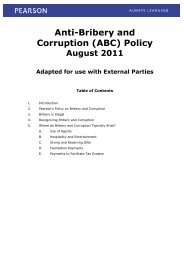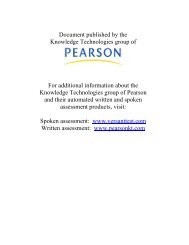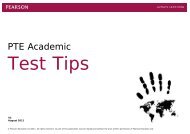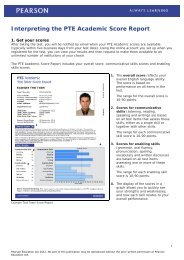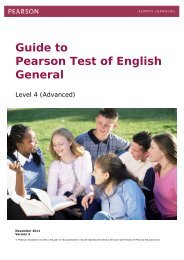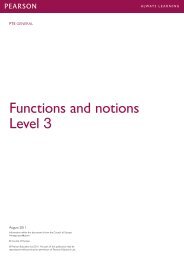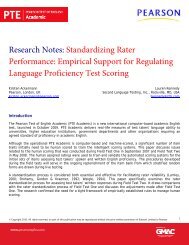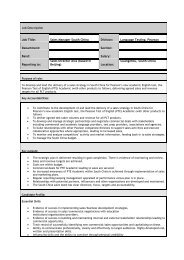Preliminary Estimates of Concordance between Pearson Test of ...
Preliminary Estimates of Concordance between Pearson Test of ...
Preliminary Estimates of Concordance between Pearson Test of ...
You also want an ePaper? Increase the reach of your titles
YUMPU automatically turns print PDFs into web optimized ePapers that Google loves.
<strong>Preliminary</strong> <strong>Estimates</strong> <strong>of</strong> <strong>Concordance</strong><br />
<strong>between</strong> <strong>Pearson</strong> <strong>Test</strong> <strong>of</strong> English Academic<br />
and other Measures <strong>of</strong> English<br />
Language Competencies<br />
Introduction<br />
This document outlines the research carried out to produce preliminary concordance <strong>between</strong> <strong>Pearson</strong> <strong>Test</strong> <strong>of</strong> English Academic<br />
(PTE Academic) and other measures <strong>of</strong> English language, including the Common European Framework (CEF or CEFR, Council <strong>of</strong><br />
Europe, 2001), TOEFL ® iBT and IELTS.<br />
<strong>Test</strong>s comparisons using field test data<br />
PTE Academic has been field tested using over 10,400 test takers. Field testing took place in 2007 and 2008. <strong>Test</strong> takers were<br />
representative <strong>of</strong> the global population <strong>of</strong> students seeking admission to universities and other tertiary education institutions<br />
where English is the language <strong>of</strong> instruction. <strong>Test</strong> takers were born in 158 different countries and spoke 126 different languages.<br />
During the field tests several sets <strong>of</strong> secondary data were collected. Among these were ratings for all test takers on descriptive<br />
scales published by the Council <strong>of</strong> Europe (2001). In addition, a number <strong>of</strong> test takers reported their scores on other tests <strong>of</strong><br />
English, including TOEIC, TOEFL PBT, TOEFL CBT, TOEFL iBT and IELTS.<br />
A limited number <strong>of</strong> the self-reported data were invalid as the reported scores were outside the possible score range for the<br />
particular test. A small number <strong>of</strong> the test takers also submitted copies <strong>of</strong> their <strong>of</strong>ficial score reports on the tests for which they had<br />
provided self-reported data. Table 1 shows the following for each test: the numbers <strong>of</strong> self-reported data, how many <strong>of</strong> these were<br />
valid, the mean self-reported scores, the number <strong>of</strong> <strong>of</strong>ficial score reports sent in, the mean <strong>of</strong>ficial scores and the correlations with<br />
the PTE Academic field test scores. All correlations are significant at p
<strong>Test</strong><br />
TOEIC<br />
TOEFL PBT<br />
TOEFL CBT<br />
TOEFL iBT<br />
IELTS<br />
n Total<br />
328<br />
96<br />
110<br />
144<br />
2436<br />
Table 1: PTE Academic field tests: test takers on other tests <strong>of</strong> English<br />
© Edexcel 2009<br />
All rights reserved. No part <strong>of</strong> this publication may be reproduced, stored in a retrieval system, or transmitted, in any form or by any means, electronic, mechanical,<br />
photocopying, recording or otherwise, without the prior permission <strong>of</strong> Edexcel Limited (a <strong>Pearson</strong> company).<br />
www.pearsonpte.com<br />
n Valid<br />
327<br />
92<br />
107<br />
140<br />
2432<br />
Self-reported data Official score report<br />
Mean<br />
831.5<br />
572.3<br />
240.5<br />
92.9<br />
6.49<br />
Correlation<br />
0.76<br />
0.64<br />
0.46<br />
0.75<br />
0.76<br />
n<br />
no data<br />
no data<br />
no data<br />
19<br />
169<br />
Mean<br />
-<br />
-<br />
-<br />
92.1<br />
6.61<br />
Correlation<br />
In addition, according to ETS (2001, p3) a score range <strong>of</strong> 800–850 on TOEIC corresponds to a score range <strong>of</strong> 569-588 on TOEFL PBT,<br />
which makes the self-reported TOEIC mean score <strong>of</strong> the test takers on the PTE Academic field test also fall in line with data<br />
published by ETS.<br />
Based on the data presented in Table 1, concordance <strong>between</strong> PTE Academic and other tests <strong>of</strong> English can be estimated,<br />
taking into account a less than optimal effort <strong>of</strong> test takers during field testing where test results have no direct relevance to the<br />
test takers.<br />
Relation with the Common European Framework<br />
The preliminary relation <strong>of</strong> the PTE Academic score scale with the descriptive scale <strong>of</strong> the Common European Framework for<br />
Languages (CEF) is based on both an item-centered and a test taker-centered method. For the item-centered method the<br />
CEFlevel <strong>of</strong> all items was estimated by item writers, reviewed and, if necessary, adapted in the item-reviewing process. For<br />
the test taker-centered method, three extended responses (one written and two spoken) per test taker were each rated by two<br />
independent, trained raters. On disagreement <strong>between</strong> the two independent raters, a third rating was gathered and the two<br />
closest ratings were retained. A dataset <strong>of</strong> over 26,000 ratings (by test takers, by items, by raters) on up to 100 different items was<br />
analyzed using the computer program FACETS (Linacre, 1988; 2005). <strong>Estimates</strong> <strong>of</strong> the lower bounds <strong>of</strong> the CEF levels based on the<br />
item-centered method correlated at .996 with those based on the test taker-centered method.<br />
Validity check using BETA testing data<br />
In addition to the initial field testing <strong>of</strong> 10,400 students during 2007-08, a further 364 test takers participated in the 2009 BETA<br />
testing <strong>of</strong> PTE Academic. The concordance <strong>between</strong> the score scale <strong>of</strong> PTE Academic and the score scales <strong>of</strong> TOEFL iBT and IELTS,<br />
each estimated from the field test data, were used as predictors <strong>of</strong> TOEFL iBT and IELTS scores <strong>of</strong> test takers participating in BETA<br />
testing. <strong>Test</strong> takers provided self-reported scores and a smaller, partially overlapping number <strong>of</strong> test takers sent in<br />
copies <strong>of</strong> their <strong>of</strong>ficial score reports.<br />
-<br />
-<br />
-<br />
0.95<br />
0.73<br />
endorsed by<br />
2
Table 2 shows the mean scores as self-reported and from the <strong>of</strong>ficial score reports, the mean scores for the same test takers as<br />
predicted from their PTE Academic score and the correlations <strong>between</strong> the reported scores and the predictions from PTE Academic.<br />
All correlations are significant at p
<strong>Preliminary</strong> estimates <strong>of</strong> concordance <strong>between</strong> PTE Academic, TOEFL iBT and the descriptive scale<br />
<strong>of</strong> the Common European Framework <strong>of</strong> Reference for Languages<br />
TOEFL<br />
iBT<br />
Score<br />
120<br />
119<br />
118<br />
117<br />
115 – 116<br />
114<br />
113<br />
112<br />
110 - 111<br />
109<br />
107 – 108<br />
106<br />
105<br />
103 – 104<br />
102<br />
101<br />
99 – 100<br />
98<br />
97<br />
95 – 96<br />
94<br />
93<br />
91 – 92<br />
90<br />
89<br />
87 - 88<br />
PTE<br />
Academic<br />
Score<br />
90<br />
89<br />
88<br />
87<br />
86<br />
85<br />
84<br />
83<br />
82<br />
81<br />
80<br />
79<br />
78<br />
77<br />
76<br />
75<br />
74<br />
73<br />
72<br />
71<br />
70<br />
69<br />
68<br />
67<br />
66<br />
65<br />
64<br />
63<br />
62<br />
61<br />
60<br />
59<br />
© Edexcel 2009<br />
All rights reserved. No part <strong>of</strong> this publication may be reproduced, stored in a retrieval system, or transmitted, in any form or by any means, electronic, mechanical,<br />
photocopying, recording or otherwise, without the prior permission <strong>of</strong> Edexcel Limited (a <strong>Pearson</strong> company). 4<br />
www.pearsonpte.com<br />
Common<br />
European<br />
Framework<br />
C2<br />
C1<br />
B2<br />
Level Descriptor<br />
© Council <strong>of</strong> Europe<br />
Can understand with ease virtually<br />
everything heard or read. Can<br />
summarize information from<br />
different spoken and written sources,<br />
reconstructing arguments and<br />
accounts in a coherent presentation.<br />
Can express him/herself spontaneously,<br />
very fluently and precisely,<br />
differentiating finer shades <strong>of</strong> meaning<br />
even in more complex situations.<br />
Can understand a wide range <strong>of</strong><br />
demanding, longer texts, and recognize<br />
implicit meaning. Can express him/<br />
herself fluently and spontaneously<br />
without much obvious searching<br />
for expressions. Can use language<br />
flexibly and effectively for social,<br />
academic and pr<strong>of</strong>essional purposes.<br />
Can produce clear, well-structured,<br />
detailed text on complex subjects,<br />
showing controlled use <strong>of</strong><br />
organizational patterns, connectors<br />
and cohesive devices.<br />
Can understand the main ideas <strong>of</strong><br />
complex text on both concrete and<br />
abstract topics, including technical<br />
discussions in his/her field <strong>of</strong><br />
specialization. Can interact with a<br />
degree <strong>of</strong> fluency and spontaneity that<br />
makes regular interaction with native<br />
speakers quite possible without<br />
strain for either party. Can produce<br />
clear, detailed text on a wide range <strong>of</strong><br />
subjects and explain a viewpoint on<br />
a topical issue giving the advantages<br />
and disadvantages <strong>of</strong> various options.<br />
What does this mean for a score user?<br />
C2 is a highly pr<strong>of</strong>icient level and a<br />
student at this level would be extremely<br />
comfortable engaging in academic<br />
activities at all levels.<br />
C1 is a level at which a student<br />
can comfortably participate in all<br />
postgraduate activities including<br />
teaching. It is not required for students<br />
entering university at undergraduate<br />
level. Most international students who<br />
enter university at a B2 level would<br />
acquire a level close to or at C1 after<br />
living in the country for several years<br />
and actively participating in all<br />
language activities encountered<br />
at university.<br />
B2 was designed as the level required<br />
to participate independently in higher<br />
level language interaction. It is typically<br />
the level required to be able to follow<br />
academic level instruction and to<br />
participate in academic education,<br />
including both coursework and<br />
student life.<br />
endorsed by
TOEFL<br />
iBT<br />
Score<br />
No data available<br />
86<br />
85<br />
83 - 84<br />
82<br />
81<br />
79 - 80<br />
78<br />
76 - 77<br />
74 - 75<br />
72 - 73<br />
70 - 71<br />
67 - 69<br />
65 - 66<br />
63 - 64<br />
60 - 62<br />
57 - 59<br />
54 - 56<br />
52 - 53<br />
48 - 51<br />
45 - 47<br />
40 - 44<br />
PTE<br />
Academic<br />
Score<br />
58<br />
57<br />
56<br />
55<br />
54<br />
53<br />
52<br />
51<br />
50<br />
49<br />
48<br />
47<br />
46<br />
45<br />
44<br />
43<br />
42<br />
41<br />
40<br />
39<br />
38<br />
35<br />
34<br />
33<br />
32<br />
31<br />
30<br />
29<br />
10<br />
© Edexcel 2009<br />
All rights reserved. No part <strong>of</strong> this publication may be reproduced, stored in a retrieval system, or transmitted, in any form or by any means, electronic, mechanical,<br />
photocopying, recording or otherwise, without the prior permission <strong>of</strong> Edexcel Limited (a <strong>Pearson</strong> company). 5<br />
www.pearsonpte.com<br />
Common<br />
European<br />
Framework<br />
B1<br />
A2<br />
A1 or<br />
below<br />
Level Descriptor<br />
© Council <strong>of</strong> Europe<br />
Can understand the main points <strong>of</strong><br />
clear standard input on familiar<br />
matters regularly encountered in<br />
work, school, leisure, etc. Can deal<br />
with most situations likely to arise<br />
whilst in an area where the language<br />
is spoken. Can produce simple<br />
connected text on topics, which are<br />
familiar, or <strong>of</strong> personal interest. Can<br />
describe experiences and events,<br />
dreams, hopes and ambitions and<br />
briefly give reasons and explanations<br />
for opinions and plans.<br />
Can understand sentences and<br />
frequently used expressions related<br />
to areas <strong>of</strong> most immediate relevance<br />
(e.g. very basic personal and family<br />
information, shopping, local geography,<br />
employment). Can communicate in<br />
simple and routine tasks requiring<br />
a simple and direct exchange <strong>of</strong><br />
information on familiar and routine<br />
matters. Can describe in simple terms<br />
aspects <strong>of</strong> his/her background,<br />
immediate environment and matters<br />
in areas <strong>of</strong> immediate need.<br />
Can understand and use familiar<br />
everyday expressions and very basic<br />
phrases aimed at the satisfaction <strong>of</strong><br />
needs <strong>of</strong> a concrete type. Can<br />
introduce him/herself and others<br />
and can ask and answer questions<br />
about personal details such as where<br />
he/she lives, people he/she knows<br />
and things he/she has. Can interact<br />
in a simple way provided the other<br />
person talks slowly and clearly and is<br />
prepared to help.<br />
What does this mean for a score user?<br />
B1 is insufficient for full academic level<br />
participation in language activities. A<br />
student at this level could ‘get by’ in<br />
everyday situations independently.<br />
To be successful in communication in<br />
university settings additional English<br />
language courses are required.<br />
A2 is an insufficient level for academic<br />
level participation.<br />
A1 is an insufficient level for academic<br />
level participation.<br />
endorsed by
<strong>Preliminary</strong> estimates <strong>of</strong> concordance <strong>between</strong> PTE Academic, IELTS and the descriptive scale <strong>of</strong> the<br />
Common European Framework <strong>of</strong> Reference for Languages<br />
IELTS<br />
Score<br />
9.0<br />
8.5<br />
8.0<br />
7.5<br />
7.0<br />
6.5<br />
PTE<br />
Academic<br />
Score<br />
90<br />
89<br />
88<br />
87<br />
86<br />
85<br />
84<br />
83<br />
82<br />
81<br />
80<br />
79<br />
78<br />
77<br />
76<br />
75<br />
74<br />
73<br />
72<br />
71<br />
70<br />
69<br />
68<br />
67<br />
66<br />
65<br />
64<br />
63<br />
62<br />
61<br />
60<br />
59<br />
© Edexcel 2009<br />
All rights reserved. No part <strong>of</strong> this publication may be reproduced, stored in a retrieval system, or transmitted, in any form or by any means, electronic, mechanical,<br />
photocopying, recording or otherwise, without the prior permission <strong>of</strong> Edexcel Limited (a <strong>Pearson</strong> company). 6<br />
www.pearsonpte.com<br />
Common<br />
European<br />
Framework<br />
C2<br />
C1<br />
B2<br />
Level Descriptor<br />
© Council <strong>of</strong> Europe<br />
Can understand with ease virtually<br />
everything heard or read. Can<br />
summarize information from<br />
different spoken and written sources,<br />
reconstructing arguments and<br />
accounts in a coherent presentation.<br />
Can express him/herself spontaneously,<br />
very fluently and precisely, differentiating<br />
finer shades <strong>of</strong> meaning even in more<br />
complex situations.<br />
Can understand a wide range <strong>of</strong><br />
demanding, longer texts, and<br />
recognize implicit meaning. Can<br />
express him/herself fluently and<br />
spontaneously without much obvious<br />
searching for expressions. Can use<br />
language flexibly and effectively for<br />
social, academic and pr<strong>of</strong>essional<br />
purposes. Can produce clear,<br />
well-structured, detailed text on complex<br />
subjects, showing controlled use <strong>of</strong><br />
organizational patterns, connectors<br />
and cohesive devices.<br />
Can understand the main ideas <strong>of</strong><br />
complex text on both concrete and<br />
abstract topics, including technical<br />
discussions in his/her field <strong>of</strong><br />
specialization. Can interact with a<br />
degree <strong>of</strong> fluency and spontaneity that<br />
makes regular interaction with native<br />
speakers quite possible without<br />
strain for either party. Can produce<br />
clear, detailed text on a wide range <strong>of</strong><br />
subjects and explain a viewpoint on<br />
a topical issue giving the advantages<br />
and disadvantages <strong>of</strong> various options.<br />
What does this mean for a score user?<br />
C2 is a highly pr<strong>of</strong>icient level and a<br />
student at this level would be extremely<br />
comfortable engaging in academic<br />
activities at all levels.<br />
C1 is a level at which a student<br />
can comfortably participate in all<br />
postgraduate activities including<br />
teaching. It is not required for students<br />
entering university at undergraduate<br />
level. Most international students who<br />
enter university at a B2 level would<br />
acquire a level close to or at C1 after<br />
living in the country for several years<br />
and actively participating in all language<br />
activities encountered at university.<br />
B2 was designed as the level required<br />
to participate independently in higher<br />
level language interaction. It is typically<br />
the level required to be able to follow<br />
academic level instruction and to<br />
participate in academic education,<br />
including both coursework and<br />
student life.<br />
endorsed by
IELTS<br />
Score<br />
No data available<br />
6.5<br />
6.0<br />
5.5<br />
5.0<br />
4.5<br />
PTE<br />
Academic<br />
Score<br />
58<br />
57<br />
56<br />
55<br />
54<br />
53<br />
52<br />
51<br />
50<br />
49<br />
48<br />
47<br />
46<br />
45<br />
44<br />
43<br />
42<br />
41<br />
40<br />
39<br />
38<br />
37<br />
36<br />
35<br />
34<br />
33<br />
32<br />
31<br />
30<br />
29<br />
10<br />
© Edexcel 2009<br />
All rights reserved. No part <strong>of</strong> this publication may be reproduced, stored in a retrieval system, or transmitted, in any form or by any means, electronic, mechanical,<br />
photocopying, recording or otherwise, without the prior permission <strong>of</strong> Edexcel Limited (a <strong>Pearson</strong> company). 7<br />
www.pearsonpte.com<br />
Common<br />
European<br />
Framework<br />
B1<br />
A2<br />
A1 or<br />
below<br />
Level Descriptor<br />
© Council <strong>of</strong> Europe<br />
Can understand the main points <strong>of</strong><br />
clear standard input on familiar matters<br />
regularly encountered in work, school,<br />
leisure, etc. Can deal with most<br />
situations likely to arise whilst in an<br />
area where the language is spoken.<br />
Can produce simple connected text<br />
on topics, which are familiar, or<br />
<strong>of</strong> personal interest. Can describe<br />
experiences and events, dreams,<br />
hopes and ambitions and briefly give<br />
reasons and explanations for opinions<br />
and plans.<br />
Can understand sentences and<br />
frequently used expressions related<br />
to areas <strong>of</strong> most immediate relevance<br />
(e.g. very basic personal and family<br />
information, shopping, local geography,<br />
employment). Can communicate in<br />
simple and routine tasks requiring<br />
a simple and direct exchange <strong>of</strong><br />
information on familiar and routine<br />
matters. Can describe in simple<br />
terms aspects <strong>of</strong> his/her background,<br />
immediate environment and matters<br />
in areas <strong>of</strong> immediate need.<br />
Can understand and use familiar<br />
everyday expressions and very basic<br />
phrases aimed at the satisfaction <strong>of</strong><br />
needs <strong>of</strong> a concrete type. Can introduce<br />
him/herself and others and can ask<br />
and answer questions about personal<br />
details such as where he/she lives,<br />
people he/she knows and things he/<br />
she has. Can interact in a simple way<br />
provided the other person talks slowly<br />
and clearly and is prepared to help.<br />
What does this mean for a score user?<br />
B1 is insufficient for full academic level<br />
participation in language activities. A<br />
student at this level could ‘get by’ in<br />
everyday situations independently.<br />
To be successful in communication in<br />
university settings additional English<br />
language courses are required.<br />
A2 is an insufficient level for academic<br />
level participation<br />
A1 is an insufficient level for academic<br />
level participation.<br />
endorsed by



